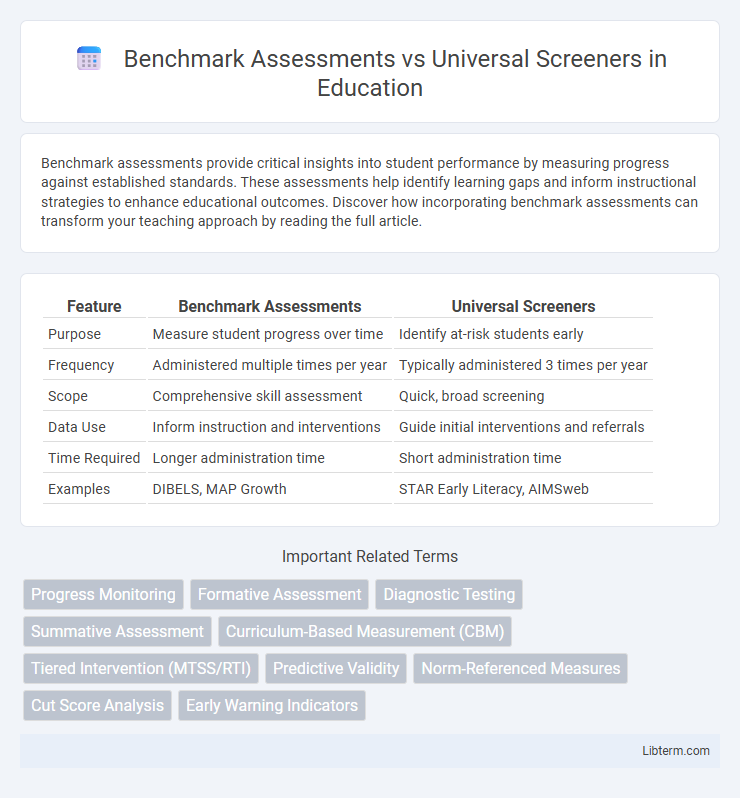Benchmark assessments provide critical insights into student performance by measuring progress against established standards. These assessments help identify learning gaps and inform instructional strategies to enhance educational outcomes. Discover how incorporating benchmark assessments can transform your teaching approach by reading the full article.
Table of Comparison
| Feature | Benchmark Assessments | Universal Screeners |
|---|---|---|
| Purpose | Measure student progress over time | Identify at-risk students early |
| Frequency | Administered multiple times per year | Typically administered 3 times per year |
| Scope | Comprehensive skill assessment | Quick, broad screening |
| Data Use | Inform instruction and interventions | Guide initial interventions and referrals |
| Time Required | Longer administration time | Short administration time |
| Examples | DIBELS, MAP Growth | STAR Early Literacy, AIMSweb |
Understanding Benchmark Assessments
Benchmark assessments provide detailed insights into student performance by measuring proficiency against grade-level standards and tracking progress over time. These assessments identify specific strengths and weaknesses, allowing educators to tailor instruction and interventions to meet individual learning needs. By analyzing data from benchmark assessments, schools can make informed decisions to improve academic outcomes and close achievement gaps.
What Are Universal Screeners?
Universal screeners are brief, standardized assessments designed to quickly identify students at risk for learning difficulties across key academic areas such as reading, math, and language skills. These screeners are administered to all students multiple times a year to ensure early detection of potential challenges, allowing for timely interventions. Unlike comprehensive benchmark assessments, universal screeners prioritize efficiency and broad coverage, providing educators with actionable data to support preventive instruction.
Key Differences Between Benchmark Assessments and Universal Screeners
Benchmark assessments provide periodic, in-depth evaluation of student progress toward specific academic standards, often used to guide instruction and monitor long-term growth. Universal screeners offer brief, frequent checks to identify students at risk for learning difficulties early, facilitating timely interventions across large groups. Key differences include assessment frequency, depth of data collected, and primary purpose, with benchmarks focusing on growth measurement and screeners emphasizing early identification.
Core Purposes: Monitoring Progress vs Identifying Risk
Benchmark assessments primarily monitor student progress by measuring proficiency and growth at regular intervals to guide instructional adjustments. Universal screeners identify students at risk for learning difficulties early by evaluating all students to pinpoint those needing further assessment. Both tools support effective educational decision-making but differ in timing and focus--progress monitoring versus risk identification.
Timing and Frequency of Assessments
Benchmark assessments are typically administered three times a year--fall, winter, and spring--to monitor student progress and adjust instruction effectively. Universal screeners occur more frequently, often monthly or quarterly, enabling early identification of learning gaps across all students. The timing difference influences intervention strategies, with benchmark assessments guiding long-term planning and universal screeners supporting immediate instructional adjustments.
Types of Data Collected
Benchmark assessments collect detailed performance data on specific learning standards or skills, providing trend analysis over time to track student growth and mastery. Universal screeners gather broad, early indicators of students' risk levels by assessing overall academic or behavioral performance to identify those needing additional support. Benchmark assessments emphasize diagnostic, progress-monitoring data, while universal screeners prioritize quick, initial identification of potential learning difficulties.
Role in MTSS/RTI Frameworks
Benchmark assessments provide critical data to monitor student progress at set intervals within the MTSS/RTI frameworks, enabling targeted instructional adjustments and identification of students needing additional support. Universal screeners quickly identify students at risk for academic difficulties by assessing all students early, ensuring timely intervention and resource allocation. Both tools play complementary roles in the data-driven decision-making process essential for effective tiered instruction and intervention planning.
Practical Examples in Schools
Benchmark assessments, such as the Dynamic Indicators of Basic Early Literacy Skills (DIBELS), provide detailed progress monitoring by measuring students' skill development at set intervals, enabling targeted instruction. Universal screeners like AIMSweb quickly identify students at risk of reading difficulties by evaluating a broad range of learners early in the school year, allowing schools to allocate resources effectively. For example, many elementary schools use DIBELS quarterly to adjust interventions, while universal screeners are administered at the start of the year to guide initial instructional planning.
Pros and Cons of Each Assessment Type
Benchmark assessments provide detailed data on student progress towards specific standards, enabling targeted instruction and measurement of growth over time; however, they often require significant time to administer and analyze. Universal screeners quickly identify students at risk across all skill areas, allowing for early intervention but may produce false positives or miss nuanced learning gaps. Both tools are essential for a balanced assessment system, with benchmarks focusing on in-depth progress monitoring and screeners emphasizing broad risk identification.
Choosing the Right Tool for Your Educational Goals
Benchmark assessments provide in-depth data on student progress over time, enabling targeted instructional adjustments based on performance trends. Universal screeners offer quick identification of students at risk, facilitating early intervention through brief, broad evaluations. Selecting the right tool depends on educational goals such as monitoring growth with benchmarks or promptly identifying learning needs through screeners.
Benchmark Assessments Infographic

 libterm.com
libterm.com